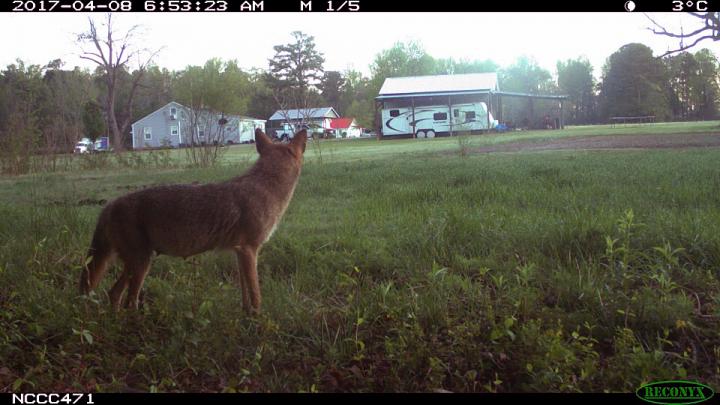Bobcats, coyotes, foxes seek green spaces in the suburbs

Credit: eMammal Project
As growth makes neighborhoods more crowded for humans, it’s also concentrating carnivores like bobcats and coyotes into the remaining green spaces, leading them to interact with each other more frequently than they do in wild areas, according to research in Raleigh, North Carolina, and Washington, D.C.
The citizen science study looks at how carnivores interact with each other when they’re sharing space in small suburban forest patches. With the help of 557 volunteers and 1,260 remote cameras set up in suburban, exurban, rural and wild areas, the researchers documented 6,413 carnivores among nearly 43,000 images of wildlife. Carnivore species included bobcats and coyotes along with smaller gray and red foxes.
“We found a lot of animal activity in the suburbs, but it was really concentrated in the remaining green space. We think carnivores are trying to avoid people, so they are moving through the strips of remaining forest, where they are more likely to interact with each other,” says lead author Arielle Parsons, researcher with the North Carolina Museum of Natural Sciences and Ph.D. student at North Carolina State University.
“What we discovered was that preserving green space in our cities is important not only for humans but also for wildlife species. Green space provides cover, it provides food and it’s a good way for carnivores to navigate without being in any danger from people.”
In general, the smaller carnivores steer clear of the larger ones. Some have theorized that smaller carnivores might stay closer to people, using them as “human shields” from larger predators. But that wasn’t borne out by the study.
“We found, on the contrary, that gray foxes and coyotes especially – our smallest species and our largest species – actually tended to use the same sites,” Parsons says. “In other words, they didn’t avoid each other, which was pretty surprising.”
For those who are wary about having carnivores in their midst, Parsons says it’s actually a good thing, given the key role they play in the ecosystem.
“Our study is showing that carnivores are trying to stay away from people by using forested areas,” Parsons says. “If we give them the opportunity to do that through preservation of green space and green space corridors through our urban areas, carnivores are going to continue to live nearby, which is actually a good thing for the ecology of our cities.”
“Just like roadways and sidewalks focus human movement and increase the potential for interaction, we find the high use of strips of remaining green space by carnivores increases their level of interaction,” says study co-author Roland Kays, a zoologist with NC State and the N.C. Museum of Natural Sciences. “This shows how urban planning can affect the ecology of animals that share cities with people.”
###
The study was supported with funding from the National Science Foundation (grants 1232442 and 1319293). The VWR Foundation, U.S. Forest Service, North Carolina Museum of Natural Sciences and Smithsonian Institution also contributed to the work.
Note: An abstract of the paper follows.
“Urbanization focuses carnivore activity in remaining natural habitats, increasing species interactions”
Authors: Arielle Parsons, N.C. Museum of Natural Sciences and North Carolina State University; Christopher T. Rota, West Virginia University; Tavis Forester, Smithsonian Conservation Biology Institute and Oregon Department of Fish and Wildlife; Megan C. Baker-Whatton, The Nature Conservancy; William J. McShea, Smithsonian Conservation Biology Institute; Stephanie G. Schuttler, N.C. Museum of Natural Sciences; Joshua J. Millspaugh, University of Montana; Roland Kays; N.C. Museum of Natural Sciences and North Carolina State University
Accepted: Journal of Applied Ecology
DOI: https:/
Abstract: 1. Interspecific interactions can provoke temporal and spatial avoidance, ultimately affecting population densities and spatial distribution patterns. The ability (or inability) of species to coexist has consequences for diversity and ultimately ecosystem stability. Urbanization is predicted to change species interactions but its relative impact is not well known. Urbanization gradients offer the opportunity to evaluate the effect of humans on species interactions by comparing community dynamics across levels of disturbance. 2. We used camera traps deployed by citizen scientists to survey mammals along urbanization gradients of two cities (Washington, DC and Raleigh, NC, USA). We used a multispecies occupancy model with four competing predator species to test whether forest fragmentation, interspecific interactions, humans or prey had the greatest influence on carnivore distribution. 3. Our study produced 6,413 carnivore detections from 1,260 sites in two cities, sampling both private and public lands. All species used all levels of the urbanization gradient to a similar extent, but co-occurrence of urban-adapted foxes with less urban-adapted bobcats and coyotes was dependent on the availability of green space, especially as urbanization increased. This suggests green space allows less urban-adapted species to occupy suburban areas, but focuses their movements through remaining forest patches, leading to more species interactions. 4. Synthesis and applications. Species interactions, forest fragmentation and human-related covariates were important determinants of carnivore occupancy across a gradient of urbanization with the relative importance of forest fragmentation being highest. We found evidence of both positive and negative interactions across the gradient with some dependent on available green space, suggesting that fragmentation leads to higher levels of spatial interaction. Where green space is adequate, there appears to be sufficient opportunity for coexistence between carnivore species in an urban landscape.
Media Contact
D’Lyn Ford
[email protected]
Related Journal Article
http://dx.




